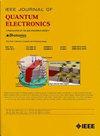Simultaneous Coherent Detection With Baseband Enhancement in Chaotic Random Bit Generation by an Optically Injected Laser
IF 2.2
3区 工程技术
Q3 ENGINEERING, ELECTRICAL & ELECTRONIC
引用次数: 0
Abstract
Optical injection into a semiconductor laser invokes chaos that is coherently detected without direct detection for fast random bit generation (RBG). Originating from the injection without any feedback, the chaos contains no undesirable time-delay signature. Although the injection dynamics only supports a low dimensionality of three, simultaneous coherent detection uses the two dimensions of intensity光注入激光产生混沌随机比特的同时相干检测与基带增强
为了实现快速随机比特生成(RBG),半导体激光器的光注入会引起混沌,而混沌是相干检测而非直接检测的。混沌起源于没有任何反馈的注入,不包含不需要的时滞特征。虽然注入动力学只支持低维度的三维,但同时相干检测使用强度$I$和相位$\varphi $这两个维度来产生两个信号$I_{\ mathm {H}}$和$I_{\ mathm {B}}$,这两个信号分别来自外差和平衡延迟同差。与直接检测的$I$相比,两个相干检测信号$I_{\mathrm{H}}$和$I_{\mathrm{B}}$是基带增强的,可以有效地利用检测器的低频响应。实验结果表明,在松弛共振频率为5.2 GHz的激光器上,$I_{\mathrm{H}}$和$I_{\mathrm{B}}$基带分别增强了8 dB和12 dB。通过丢弃比特的基本后处理,将其数字化为RBG,输出比特率达到280gbps。通过涉及伪随机贡献的广泛后处理,即使检测带宽降低到3 GHz,也可以提高1.28 Tbps的输出比特率。这两种后处理都满足美国国家标准与技术研究所(National Institute of Standards and Technology)的一套标准化随机性测试。基于同步相干检测,说明了基带增强对注入低维动态的潜力。
本文章由计算机程序翻译,如有差异,请以英文原文为准。
求助全文
约1分钟内获得全文
求助全文
来源期刊

IEEE Journal of Quantum Electronics
工程技术-工程:电子与电气
CiteScore
4.70
自引率
4.00%
发文量
99
审稿时长
3.0 months
期刊介绍:
The IEEE Journal of Quantum Electronics is dedicated to the publication of manuscripts reporting novel experimental or theoretical results in the broad field of the science and technology of quantum electronics. The Journal comprises original contributions, both regular papers and letters, describing significant advances in the understanding of quantum electronics phenomena or the demonstration of new devices, systems, or applications. Manuscripts reporting new developments in systems and applications must emphasize quantum electronics principles or devices. The scope of JQE encompasses the generation, propagation, detection, and application of coherent electromagnetic radiation having wavelengths below one millimeter (i.e., in the submillimeter, infrared, visible, ultraviolet, etc., regions). Whether the focus of a manuscript is a quantum-electronic device or phenomenon, the critical factor in the editorial review of a manuscript is the potential impact of the results presented on continuing research in the field or on advancing the technological base of quantum electronics.
 求助内容:
求助内容: 应助结果提醒方式:
应助结果提醒方式:


